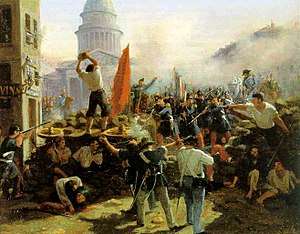June Days uprising
.jpg) Barricades on rue Saint-Maur during the uprising, 25 June 1848 | |
| Date | 23 June 1848 – 26 June 1848 |
|---|---|
| Location | France |
| Participants | Urban unemployed |
| Outcome | Uprising is a failure; however, the provisional government puts forward a new constitution and elections are called in which Louis-Napoleon Bonaparte is elected. |
The June Days uprising (French: les journées de Juin) was an uprising staged by the workers of France from 23 to 26 June 1848.[1] It was in response to plans to close the National Workshops, created by the Second Republic in order to provide work and a source of income for the unemployed, albeit with pay just enough to survive.[2] The National Guard, led by General Louis Eugène Cavaignac, was called out to quell the protests. Things did not go peacefully and over 10,000 people were either killed or injured, while 4,000 insurgents were deported to Algeria. This marked the end of the hopes of a "Democratic and Social Republic" (République démocratique et sociale) and the victory of the liberals over the Radical Republicans.
Background
During this time, France was in a period of internal turmoil and had gone through many revolutions, such as those of July 1830 and the February 1848.[1] A provisional government, called the Second Republic, was declared after the abdication of Louis Philippe in February. This was a democratic republic and immediately democratic reforms were being enacted, including universal male suffrage. To combat unemployment, the National Workshops were created which provided jobs and wages. These Workshops were a tremendous success attracting many unemployed persons; however, to fund these Workshops new taxes were applied to lands. This alienated land owners, among them peasants, from the provisional government as they did not like the idea of paying money so that the unemployed could have the "right to work". As a result, these land taxes were not adhered to, causing a financial problem for the Second Republic.[3][4]
On 23 April 1848, the French people elected a mainly moderate and conservative constituent assembly; this angered radicals in Paris, who saw this as contrary to their vision. The radicals invaded the assembly, as they believed that their democratic republic was being eroded away. This action was quickly thwarted; however, it sparked fear in conservatives, who were becoming a parliamentary majority. Soon, the conservative majority closed down the National Workshops, which sparked three days of bloody unrest.[4]
Uprising


On 23 June, the Comte de Falloux's committee issued a decree stating the Workshops would be closed in three days and that the options were that young men could join the army, provincials could return home or they could simply be dismissed.[2] The anger surrounding the closing of the Workshops increased, and shortly after that, the uprising began.[1] In sections of the city, hundreds of barricades were thrown up which blocked communication and reduced the mobility of persons.[2] The National Guard was called out to halt rioting; this sparked fighting once the guard and protesters clashed.[2]
The labourers had now become insurgents and were breaking stones to use as barricades.[2] The numbers of military members were estimated to be over 40,000; however, the number of insurgents was estimated to be higher and was growing as they traveled from house to house recruiting other citizens to join them, threatening them with death if they refused.[2] The insurgents also seized many armories to gather weapons.[2]
By 26 June, the revolution was over, and more than 10,000 people were either killed or injured, including about 1,500 troops and about 3,000 insurgents killed. Furthermore, over 4,000 insurgents were deported to Algeria. After the insurgents were crushed, all ideas of a revolution were abandoned.[1][2]
Aftermath
The French Constitution of 1848 was adopted, stating that executive power should be wielded by a President of the Republic and that the people should elect this president every four years.[5] Once a president was elected he would have the power to appoint Ministers and other high-ranking officials.[5] The constitution provided provision for an Assembly of 750 legislators who were to be elected by the people every three years.[5] After the constitution was enacted, elections were held and Louis-Napoleon Bonaparte was elected. After three years in power, Bonaparte staged a coup d'état, extending his mandate for ten years; he went on to establish the Second French Empire.[1]
See also
References
- 1 2 3 4 5 Peacock, Herbert L. (1982). "5". A History of Modern Europe 1789–1981. pp. 91–112. ISBN 978-0-435-31720-1.
- 1 2 3 4 5 6 7 8 Castelli, Helen. "June Days (June 22–26, 1848)". Retrieved 4 April 2017.
- ↑ de Luna, Frederick. "Provisional Government of the Second French Republic".
- 1 2 "Silvapages". Archived from the original on 17 February 2008. Retrieved 25 January 2012.
- 1 2 3 Sache, Ivan. "France: Second Republic (1848–1852)". Flags of the World. Retrieved 8 October 2010. ; for a French Analysis of this Constitution, Arnaud Coutant, 1848, quand la republique combattait la democratie, mare et martin 2009
External links
![]()
- Marx & Engels articles published from June to November 1848 in the Neue Rheinische Zeitung
- Les journées de juin 1848, K. Marx – F. Engels.